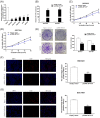The pseudogene-derived long non-coding RNA SFTA1P suppresses cell proliferation, migration, and invasion in gastric cancer
- PMID: 29523596
- PMCID: PMC5968191
- DOI: 10.1042/BSR20171193
The pseudogene-derived long non-coding RNA SFTA1P suppresses cell proliferation, migration, and invasion in gastric cancer
Abstract
Pseudogenes were once regarded as transcriptionally inactive and without specific molecular function. However, current evidence shows that pseudogene-derived long non-coding RNAs (lncRNAs) may be crucial regulators of human cancer development, including gastric cancer (GC). In the present study, we report that a pseudogene-derived lncRNA named surfactant associated 1, pseudogene (SFTA1P), which is 693-nt long, was significantly down-regulated in GC tissues compared with that in the adjacent normal tissues. In addition, decreased SFTA1P expression was strongly correlated with advanced tumor lymph node metastasis (TNM) stage, larger tumor size, lymphatic metastasis, and poor prognosis of patients with GC. Moreover, gain-of-function experiments revealed that the overexpression of SFTA1P inhibits cell proliferation, migration, and invasion, thus verifying the tumor inhibitory role of SFTA1P in GC. Furthermore, we investigated the potential action mechanism of SFTA1P. Our results showed that down-regulation of SFTA1P may be associated with decreased TP53 expression. In summary, our work suggests that the pseudogene-derived lncRNA SFTA1P functions as a tumor suppressor in GC and thus may act as a potential diagnostic and therapeutic target of GC.
Keywords: SFTA1P; gastric cancer; lncRNA; pseudogene.
© 2018 The Author(s).
Conflict of interest statement
The authors declare that there are no competing interests associated with the manuscript.
Figures






Similar articles
-
The pseudogene-derived long noncoding RNA SFTA1P is down-regulated and suppresses cell migration and invasion in lung adenocarcinoma.Tumour Biol. 2017 Feb;39(2):1010428317691418. doi: 10.1177/1010428317691418. Tumour Biol. 2017. PMID: 28231733
-
Increased lncRNA AFAP1-AS1 expression predicts poor prognosis and promotes malignant phenotypes in gastric cancer.Eur Rev Med Pharmacol Sci. 2017 Oct;21(17):3842-3849. Eur Rev Med Pharmacol Sci. 2017. PMID: 28975981
-
Role of long non-coding RNA HULC in cell proliferation, apoptosis and tumor metastasis of gastric cancer: a clinical and in vitro investigation.Oncol Rep. 2014 Jan;31(1):358-64. doi: 10.3892/or.2013.2850. Epub 2013 Nov 14. Oncol Rep. 2014. PMID: 24247585
-
Pathological roles of miRNAs and pseudogene-derived lncRNAs in human cancers, and their comparison as prognosis/diagnosis biomarkers.Pathol Res Pract. 2024 Jan;253:155014. doi: 10.1016/j.prp.2023.155014. Epub 2023 Dec 12. Pathol Res Pract. 2024. PMID: 38128189 Review.
-
Pseudogene-Derived lncRNAs and Their miRNA Sponging Mechanism in Human Cancer.Front Cell Dev Biol. 2020 Feb 28;8:85. doi: 10.3389/fcell.2020.00085. eCollection 2020. Front Cell Dev Biol. 2020. PMID: 32185172 Free PMC article. Review.
Cited by
-
Comprehensive analysis of lncRNA-associated competing endogenous RNA network in tongue squamous cell carcinoma.PeerJ. 2019 Feb 6;7:e6397. doi: 10.7717/peerj.6397. eCollection 2019. PeerJ. 2019. PMID: 30755833 Free PMC article.
-
Transcriptomic and functional network features of lung squamous cell carcinoma through integrative analysis of GEO and TCGA data.Sci Rep. 2018 Oct 26;8(1):15834. doi: 10.1038/s41598-018-34160-w. Sci Rep. 2018. PMID: 30367091 Free PMC article.
-
The dysregulation and clinical relevance of lncRNAs MYOSLID and SFTA1P in colorectal cancer patients.Mol Biol Rep. 2024 Oct 30;51(1):1109. doi: 10.1007/s11033-024-10020-x. Mol Biol Rep. 2024. PMID: 39476151
-
LPAL2 Suppresses Tumor Growth and Metastasis of Hepatocellular Carcinoma by Modulating MMP9 Expression.Cells. 2022 Aug 22;11(16):2610. doi: 10.3390/cells11162610. Cells. 2022. PMID: 36010685 Free PMC article.
-
Overexpressed pseudogenes, DUXAP8 and DUXAP9, promote growth of renal cell carcinoma and serve as unfavorable prognostic biomarkers.Aging (Albany NY). 2019 Aug 13;11(15):5666-5688. doi: 10.18632/aging.102152. Epub 2019 Aug 13. Aging (Albany NY). 2019. PMID: 31409759 Free PMC article.
References
Publication types
MeSH terms
Substances
LinkOut - more resources
Full Text Sources
Other Literature Sources
Medical
Research Materials
Miscellaneous

